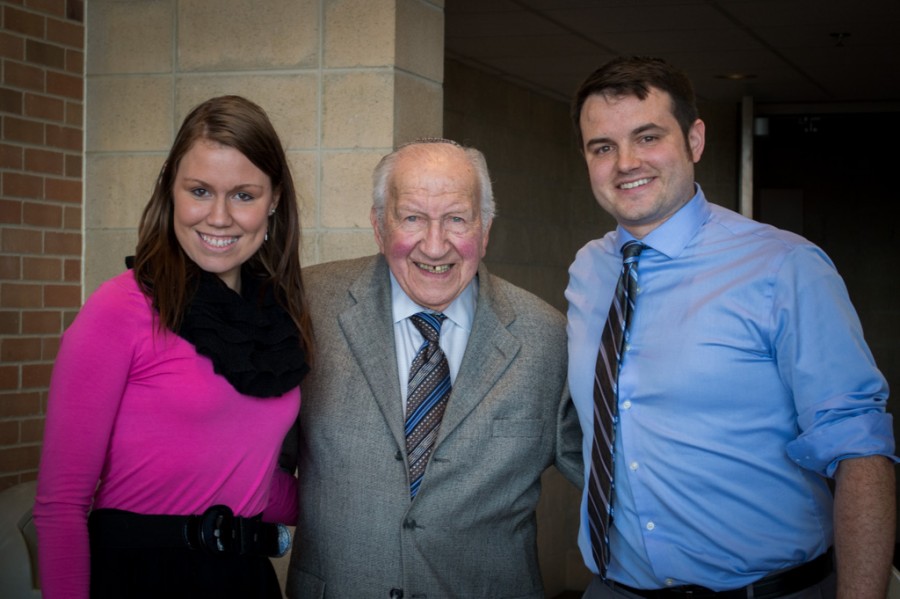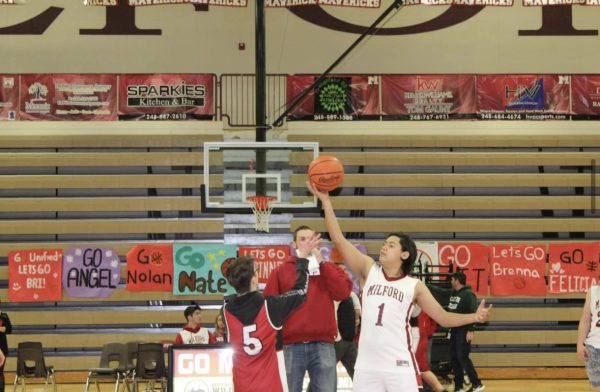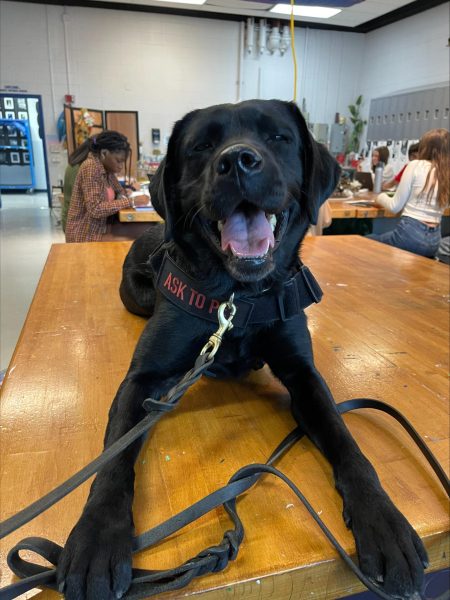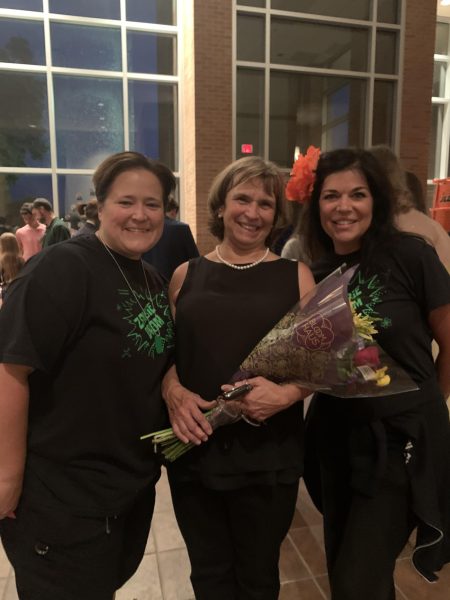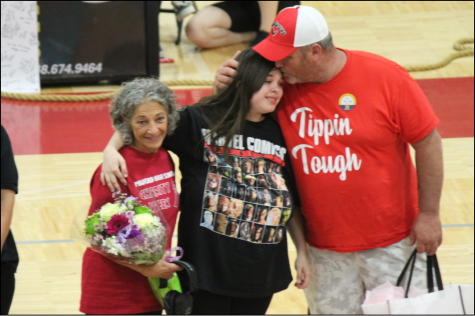Holocaust survivor discusses the horrors of his past to educate teenagers
Martin Lowenberg stands with MHS English teacher, Rob Hamilton and student teacher, Jennifer Marshman, who was determined to have him present to students.
March 24, 2016
¨I was not that fortunate, to have gotten an education and diploma, because my life was shattered from the time I was 5. For 12 long years I faced the Devil. So many people under the age of 15 had their lives cut short, snuffed out by a man who knew nothing of love,¨ announced 88-year-old Holocaust Survivor, Martin Lowenberg.
On Monday, March 21, 2016, Lowenberg arrived at Milford High School to educate the freshmen class on the horror he faced growing up. To most, the Holocaust seems like a distant memory but for Lowenberg, it’s been part of who he is for nearly all of his life.
Lowenberg was just 5-years old when Adolf Hitler came to power in 1933. He’d grown up in Schenklengsfeld, Germany with his parents and siblings.
The last time he recalls being in a public school was when he was ¨a little boy of 8¨. ¨It was Hitler’s birthday,¨ Lowenberg divulged. ¨I was accused of sticking my tongue out at his portrait. My teacher had four boys beat me up. I was on the floor, crying out of pain, and it wasn’t enough for my teacher. One minute I’m on the ground crying and the next my teacher has pulled me from the floor and thrown me onto a stool where he’d placed a wooden board with nails.¨
¨I spent the next two years in a boarding school,¨ he stated, ¨and I was lucky to go home to visit my family.¨
Nov. 9th could be described as one of the first horror-filled days that Lowenberg would encounter. Stones of all sizes were thrown through the classroom windows, leaving two classmates bloody.
¨Our teachers were so scared that they sent us home,¨ he described. ¨When I got home there were people being drug through the streets, and our synagogues were burning. There were over 90 people killed that day. There were people [our neighbors] shouting ‘Out with the Jews, we don’t want them here’.”
There was nearly nothing left the next day when all of the men were arrested and taken to one of three concentration camps. Some people, like his father, were able to come home after four weeks.
Life had drastically changed for the Jewish population after that. Not only was a ‘Jew tax’ put into place, but everyone was given an ID card. It wouldn’t have been that bad if it was a normal id, but they were clearly labeled by both their gender- women were all given the middle name of ‘Sarah’ and men were given the middle name ‘Israel’- along with a small Star of David. People had quickly begun to limit their interactions with the Jewish community and it grew nearly impossible to get the supplies needed for daily life.
“In the middle of the night, people- very nice people- brought us the supplies that we needed. Each night they took their lives in their own hands to make sure we had something to eat,” Lowenberg continued.
It wasn’t until Dec. of 1941 that they were given badges to wear on their clothing that identified their religion. For most Americans, Dec. 7, is known for the attack on Pearl Harbor, but for Lowenberg and many others, the day after was of more importance.
Hitler had has private army round up the Jewish population and anyone else he suspected of being ‘a dirty Jew’ and had them herded like cattle to the railroad station. They waited for the trains to come and then were packed into cattle cars. There were anywhere between 80-100 people in a single car that contained an unbelievable stench for four days and nights.
When the trains reached the next location, anyone that couldn’t walk, were sick or had babies, were put into trucks and buses. As they were told that they’d be reunited with their families later on, they accepted this and climbed up, but that wasn’t the case. Most of them were killed shortly after.
Five long miles later, they arrived at a ghetto where everything was buried in snow. In two days at least 3,000 people were killed. They were required to work every day, and this lasted for more than a year and a half.
Before long, women between the ages of 15 and 50 were taken away. After nearly a month, the men between 15-50 joined the women in the concentration camps. As Lowenberg was 15, he was taken away from his parents and younger brothers- twin boys.
“Upon our arrival, we were given a uniform. Striped clothes with numbers on them. We no longer had names. I was no longer Martin but #3698, and we were no longer people, but slaves.” Lowenberg recalled. “We had very little to eat- a very watery soup and a thin slice of bread. There were anywhere from 200 to 225 people in a single barrack.”
It wasn’t until Nov. 2, 1943 that the ghetto was liquidated. Anyone under the age of 14 and over 50 were taken to a freight depot and transported to Poland where they ended up in Auschwitz. With the exception of twins, everyone was sent to the gas chambers where they were gassed. Twins endured a much more horrific time in the camp. Over 3,000 twins were given to Josef Mengele, better known as the Butcher of Auschwitz, where he performed experiments that ended up killing them.
“I can only hope that my twin brothers went with my parents to the gas chambers. All I can really say is that God took care of them. They’re dead now,” Lowenberg said sadly, “I was orphaned at the age of 15. I did it all on my own.”
After spending six weeks in a concentration camp, we were forced to walk 75 miles to another camp. Fake Red-Cross trucks were parked outside of the camp. As people were under the impression that they were getting real help, they willingly climbed into the trucks, unaware of the gas hoses inside. Once they were a safe distance from the camp, they were gassed, their bodies were gotten rid of, and the trucks returned for another load of passengers.
“Finally I was taken to Sweden where we were liberated and I was able to reunite with my sister Eva. After a long process of being quarantined and rehabilitated, everyone was reunited with their families. It was a year later when Eva and I traveled here to America, to the land of the free,” Lowenberg finished.
After Lowenberg concluded, the audience, of 500 or so students, all gave him a standing ovation to show their respect. He was very thankful for the courteousness of the Milford High students, and many students stayed after to personally thank him for sharing his tragic story.
For more information on what Lowenberg and others went through, you can visit the Holocaust Museum Monday thru Friday from 9:30 a.m. to 5 p.m., Lowenberg’s website (http://www.holocaustcenter.org/page.aspx?pid=644) or the Holocaust Memorial Center’s website (http://www.holocaustcenter.org/home).
